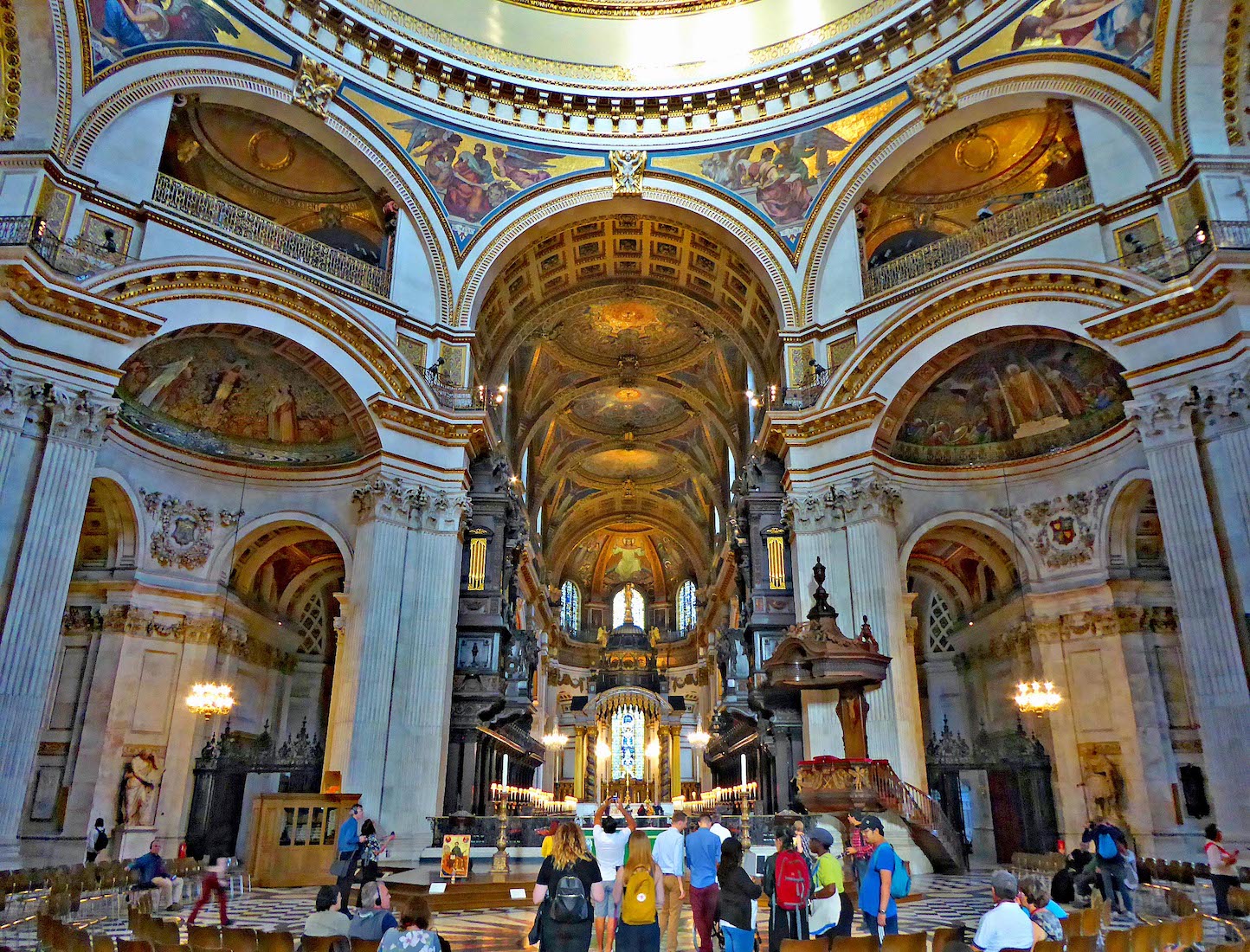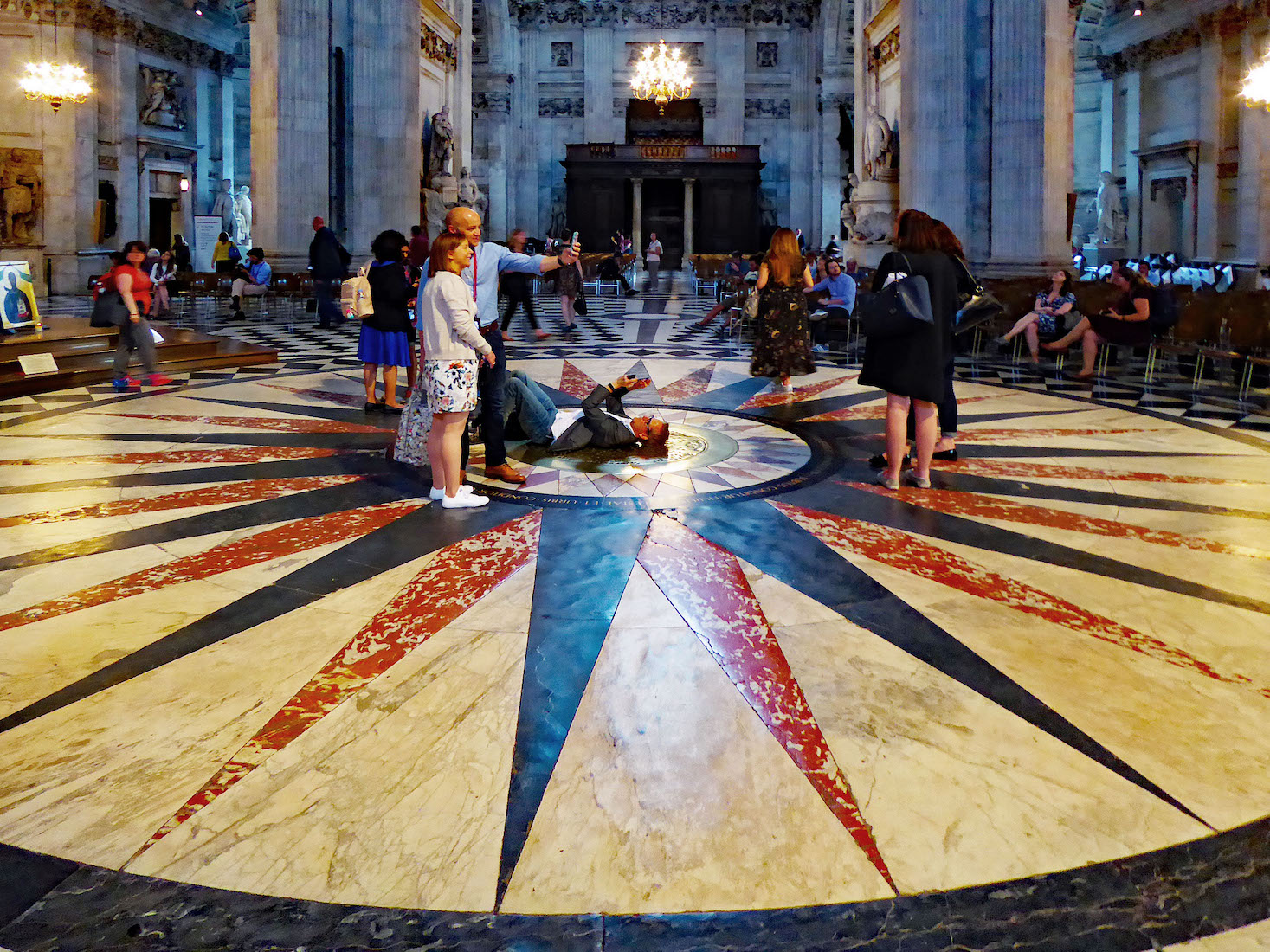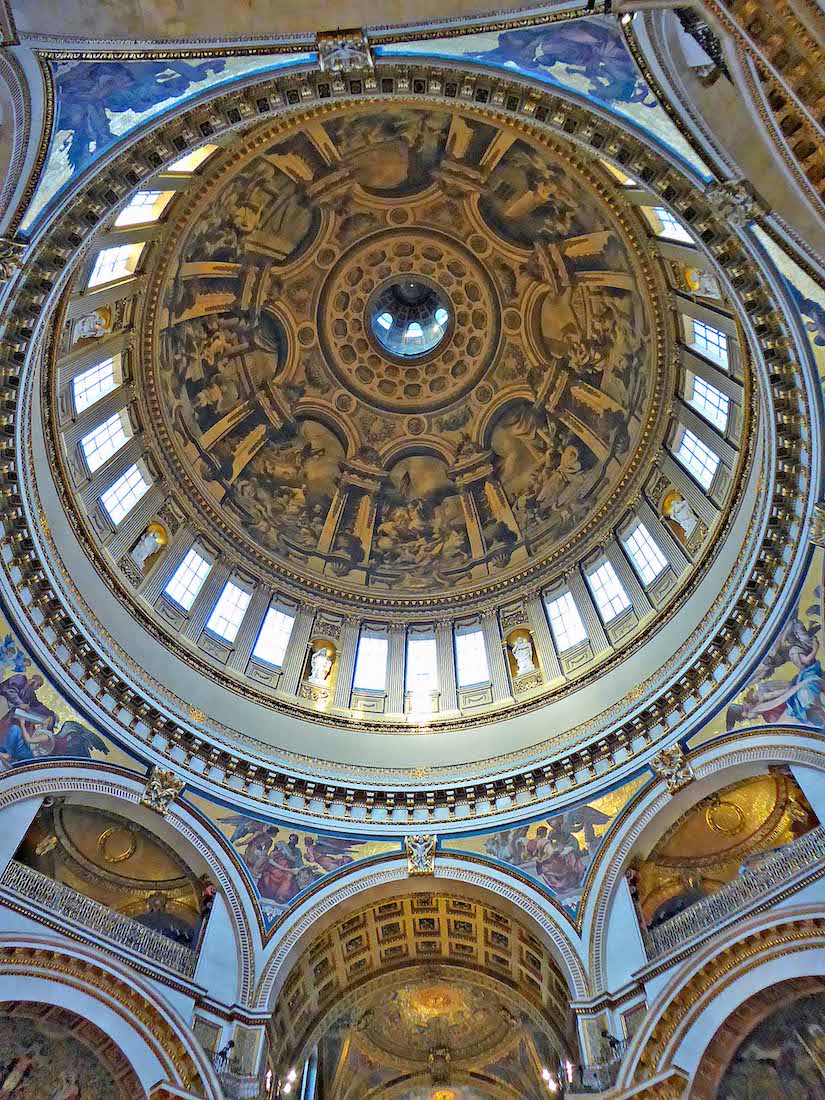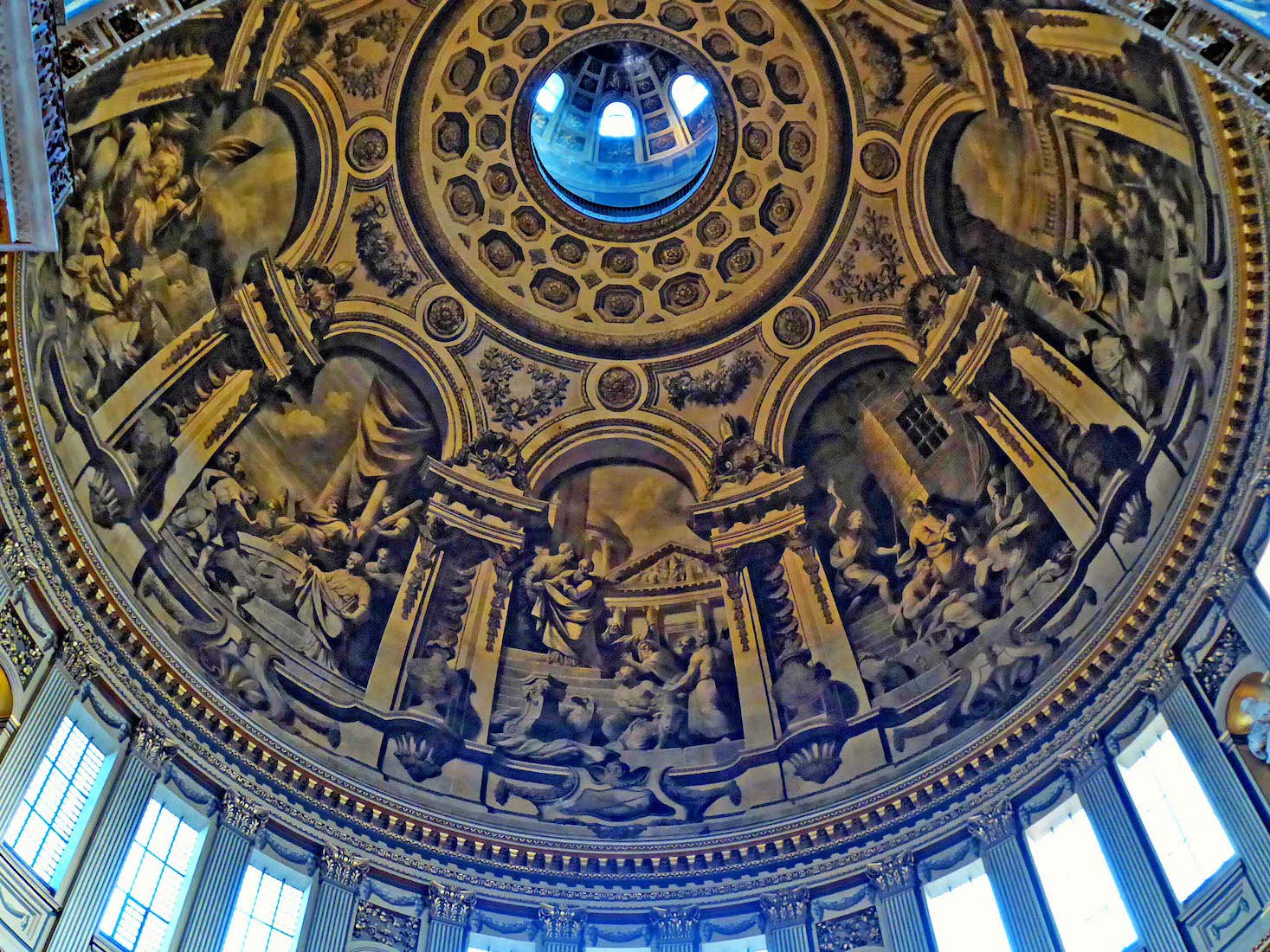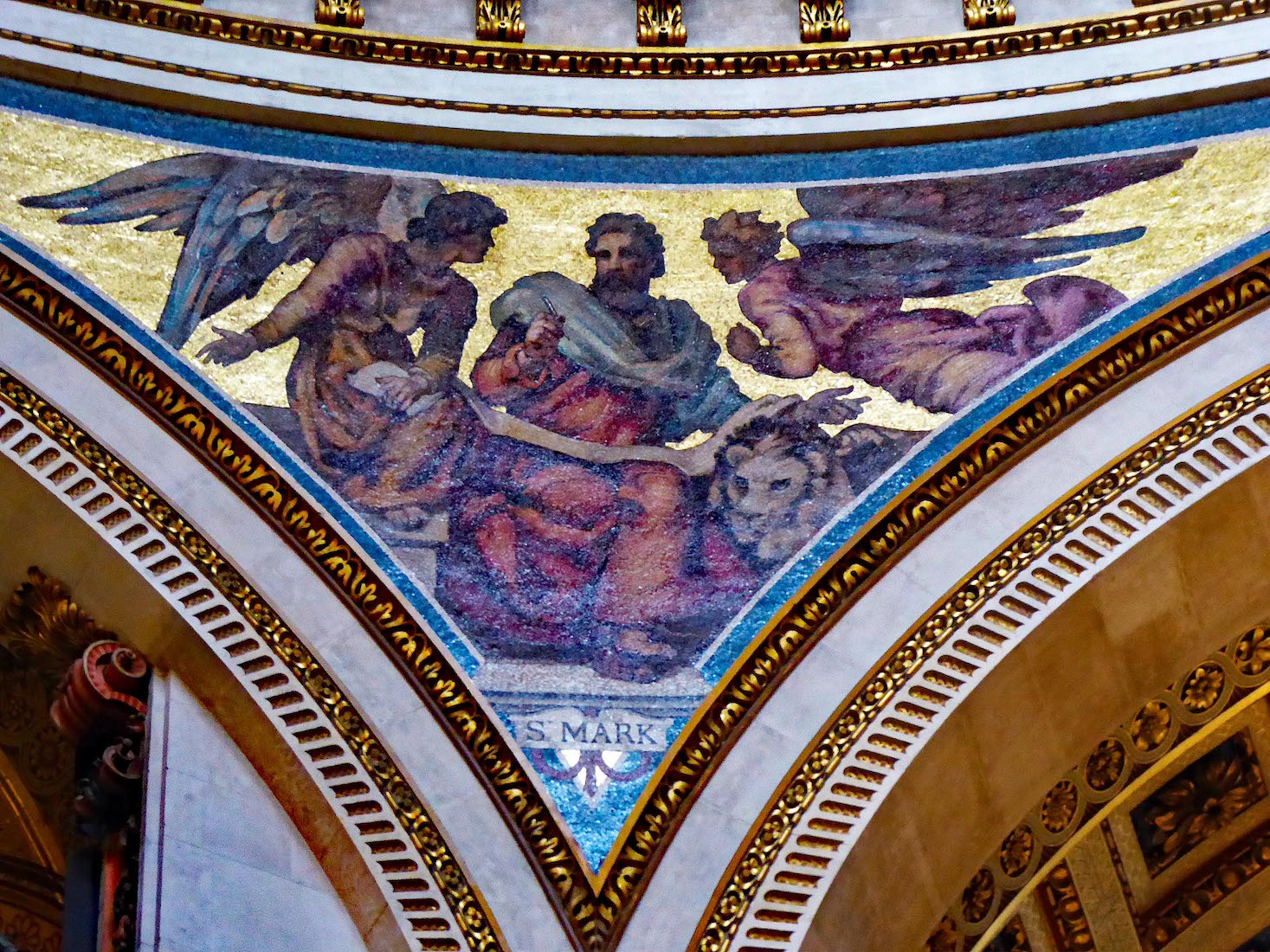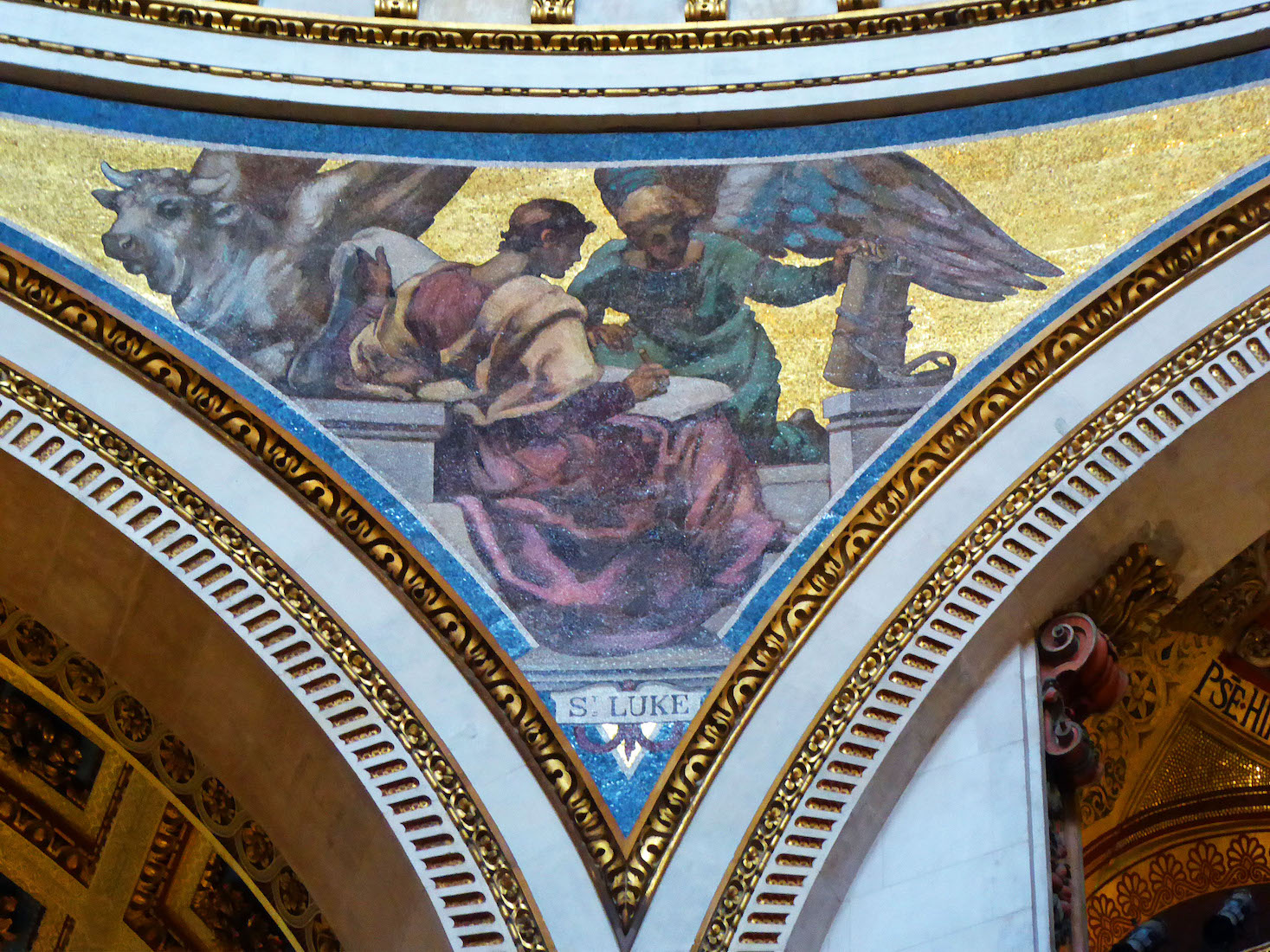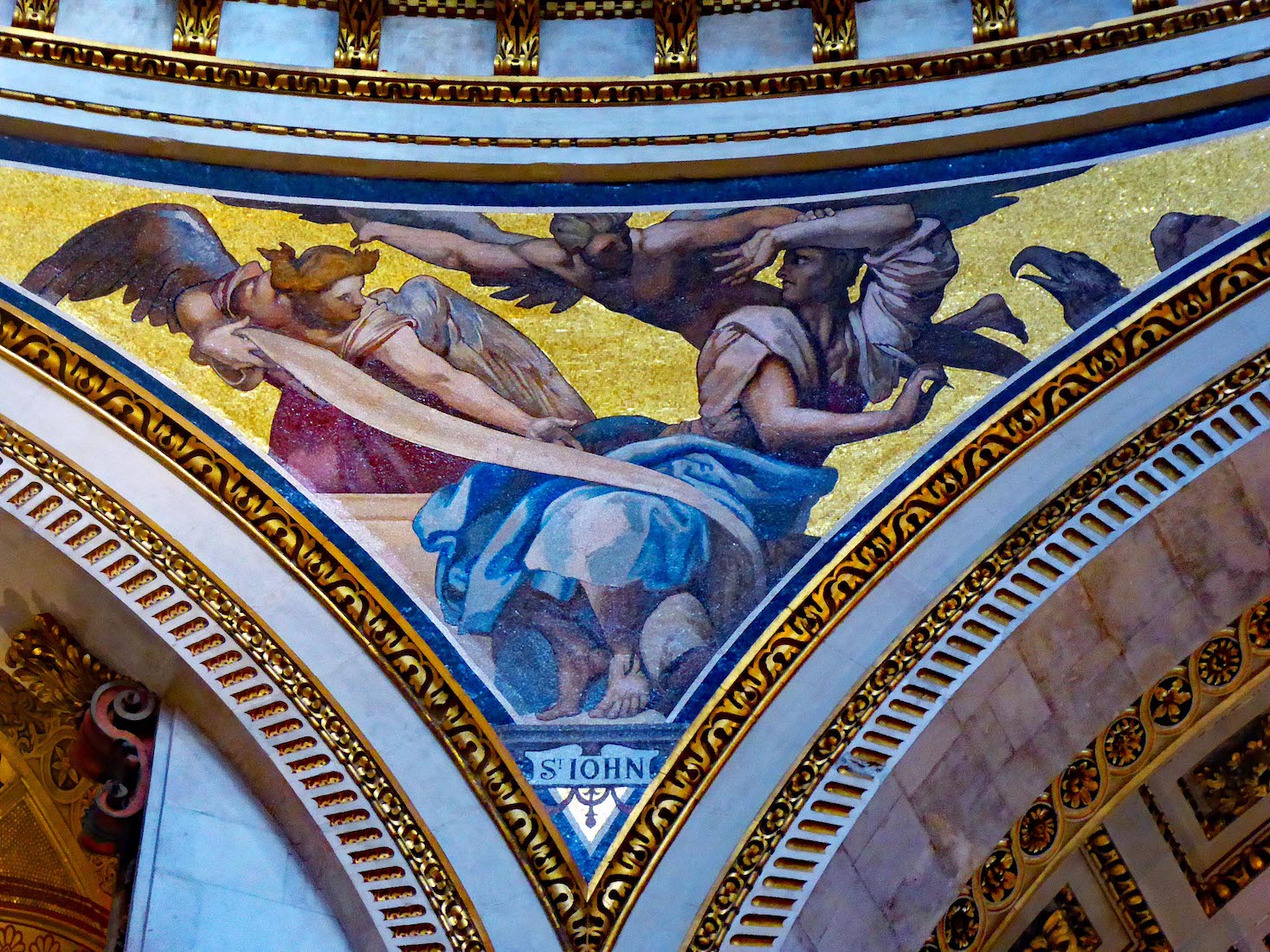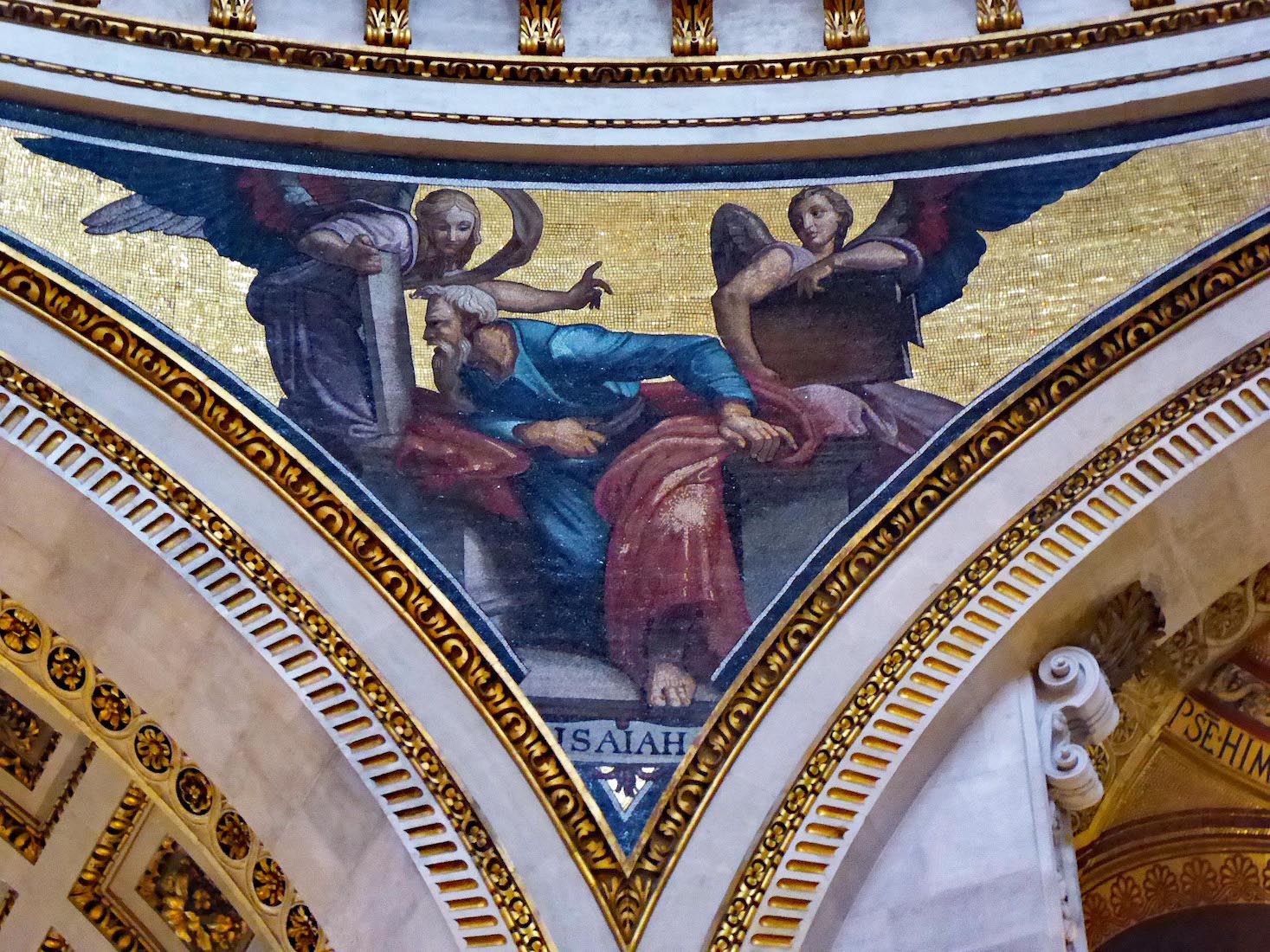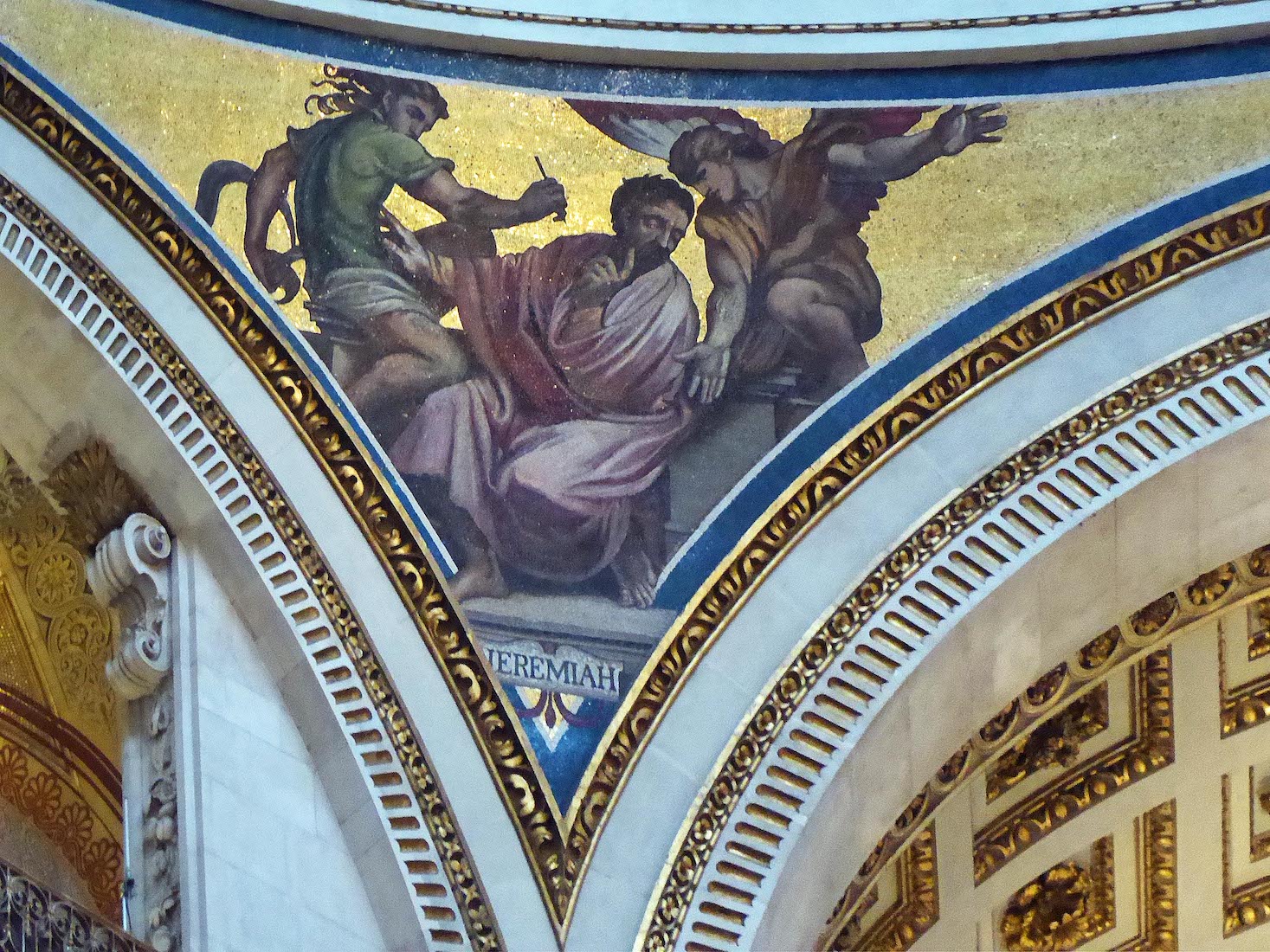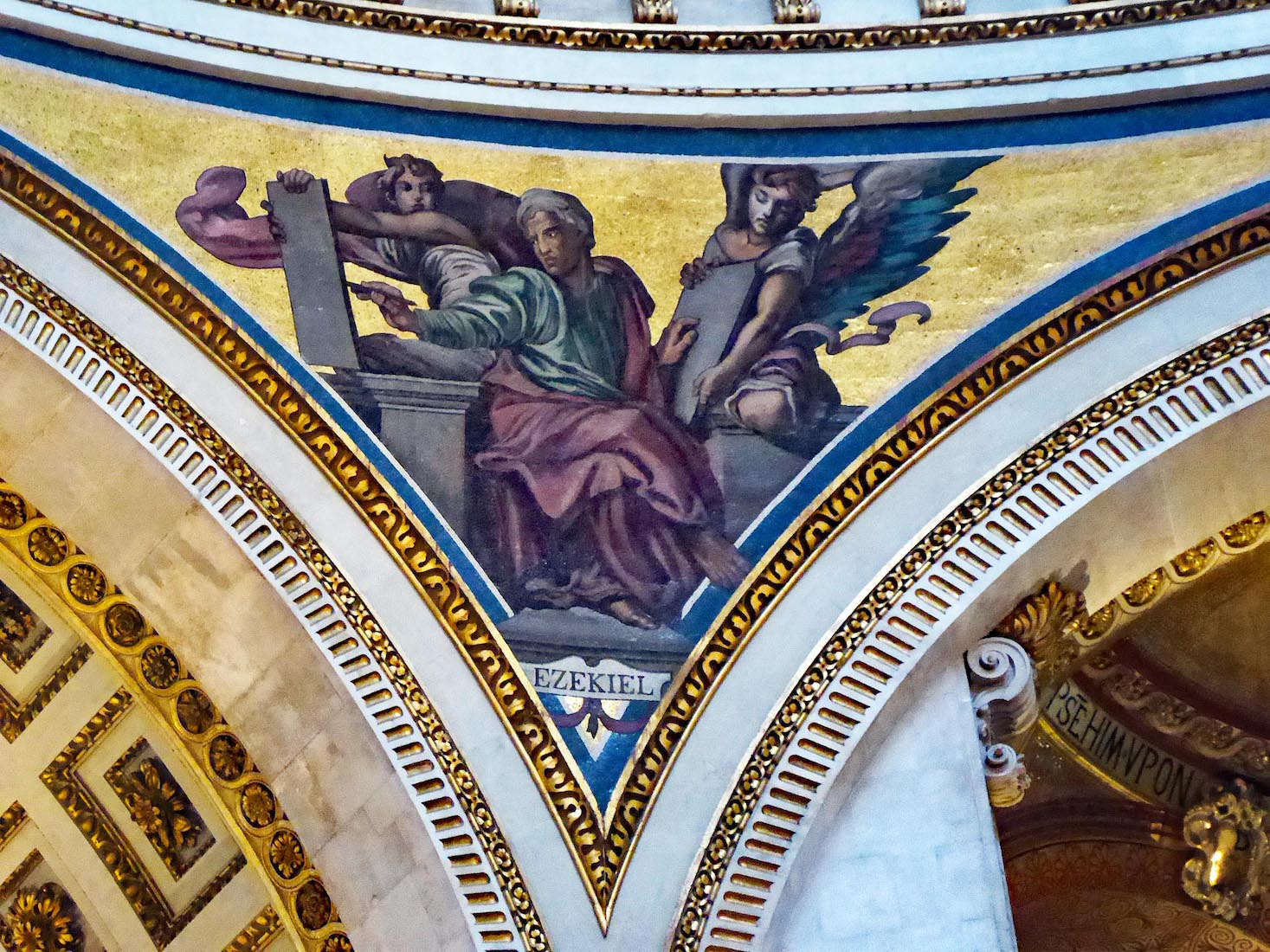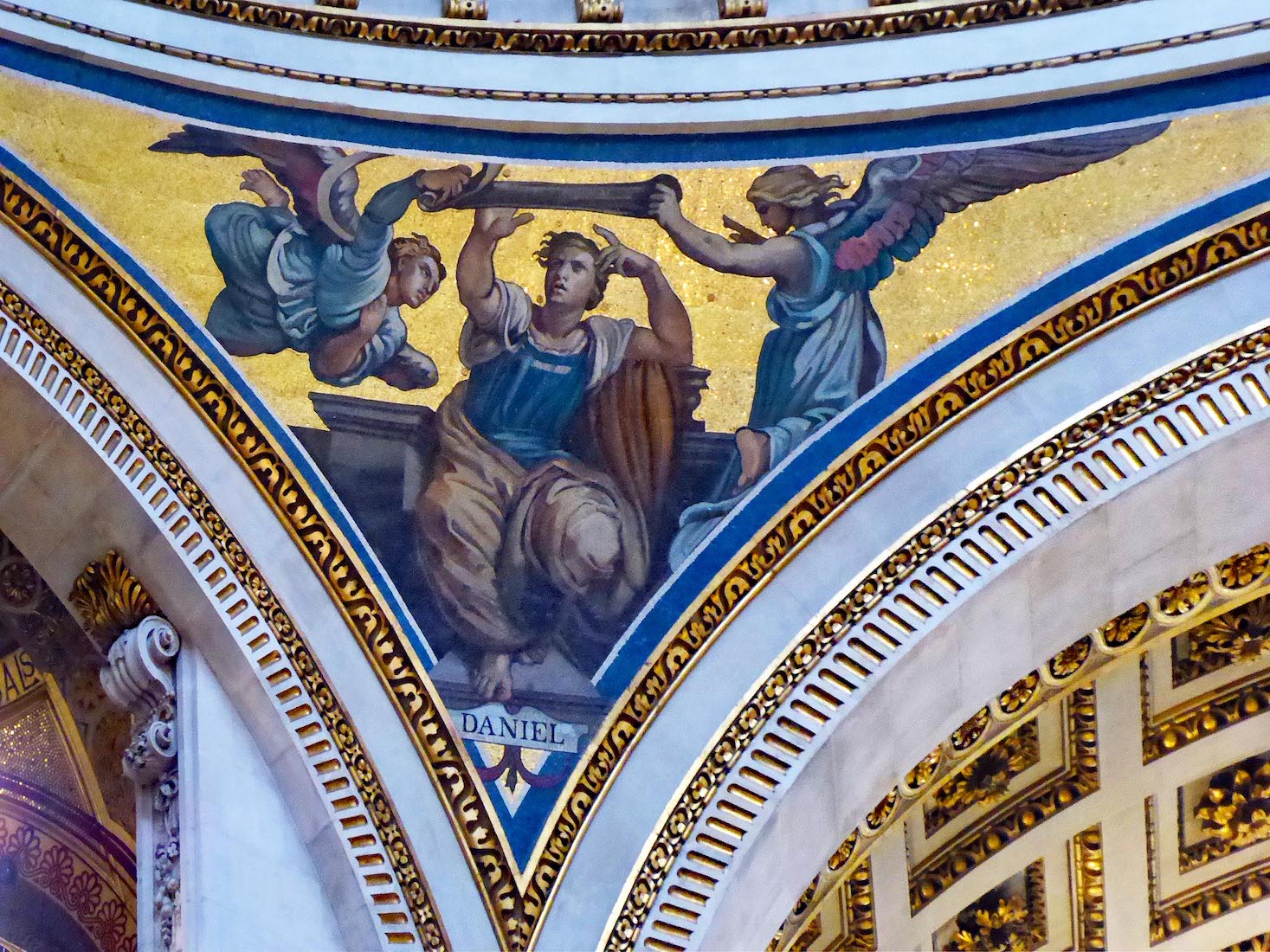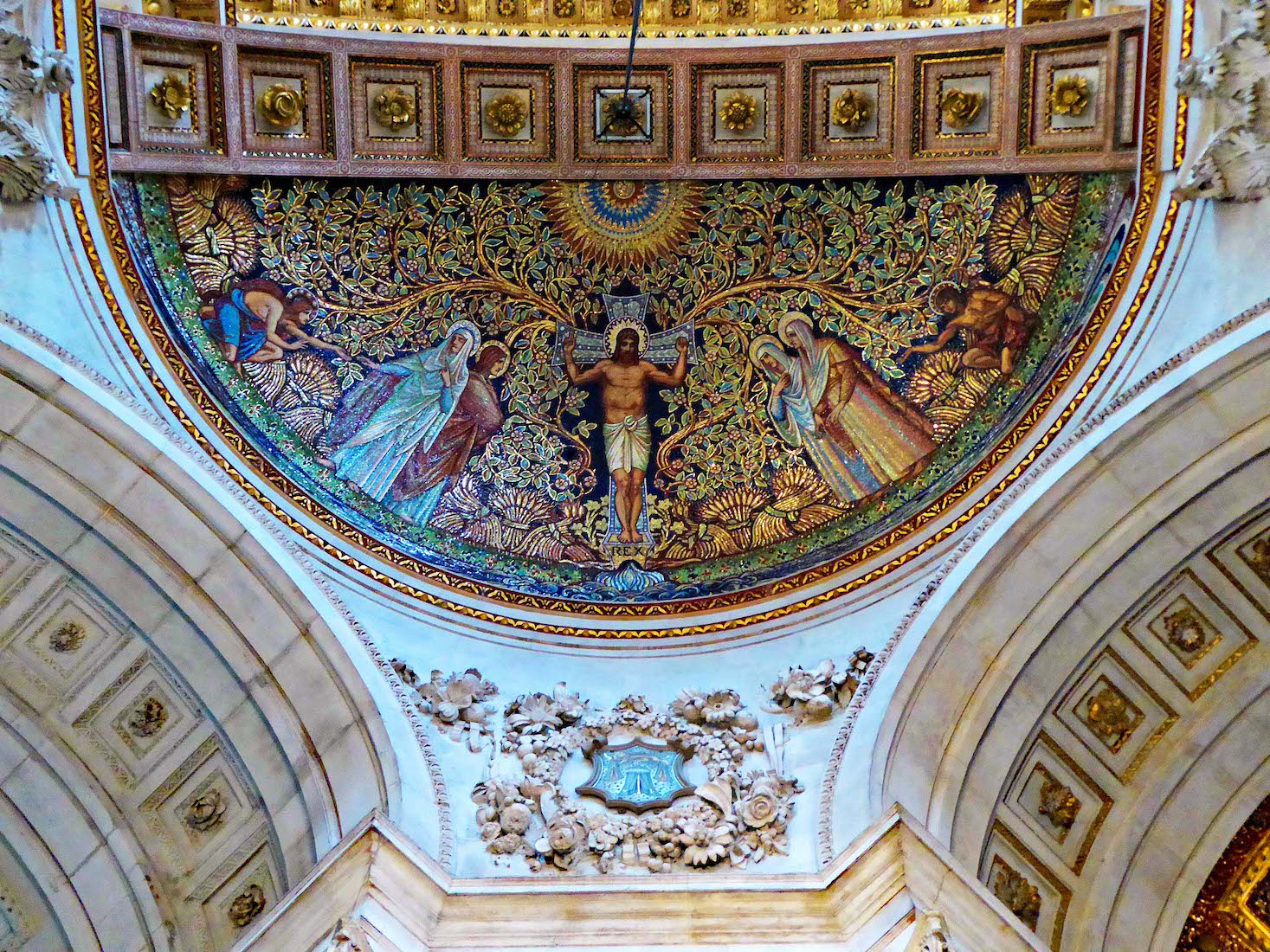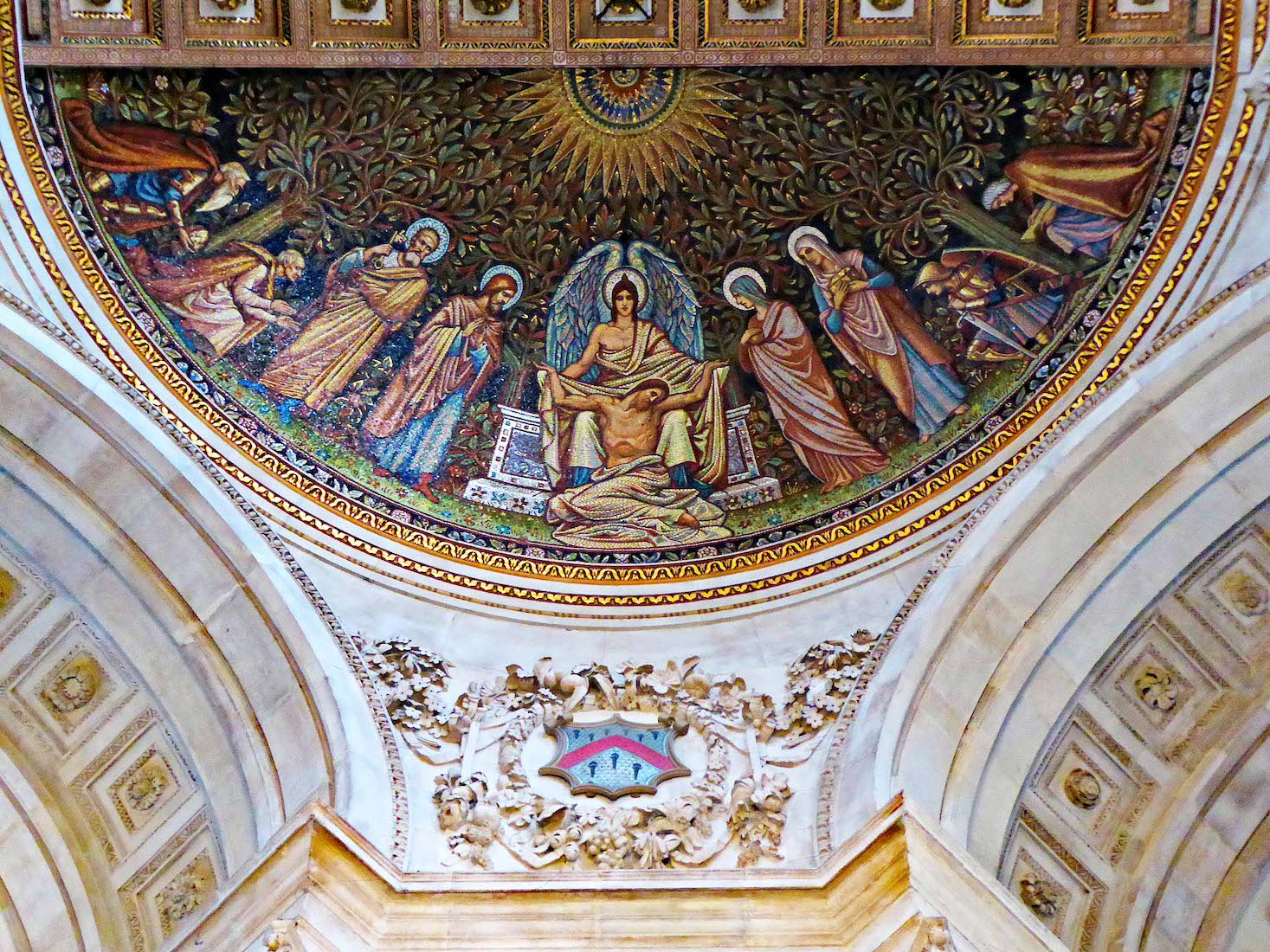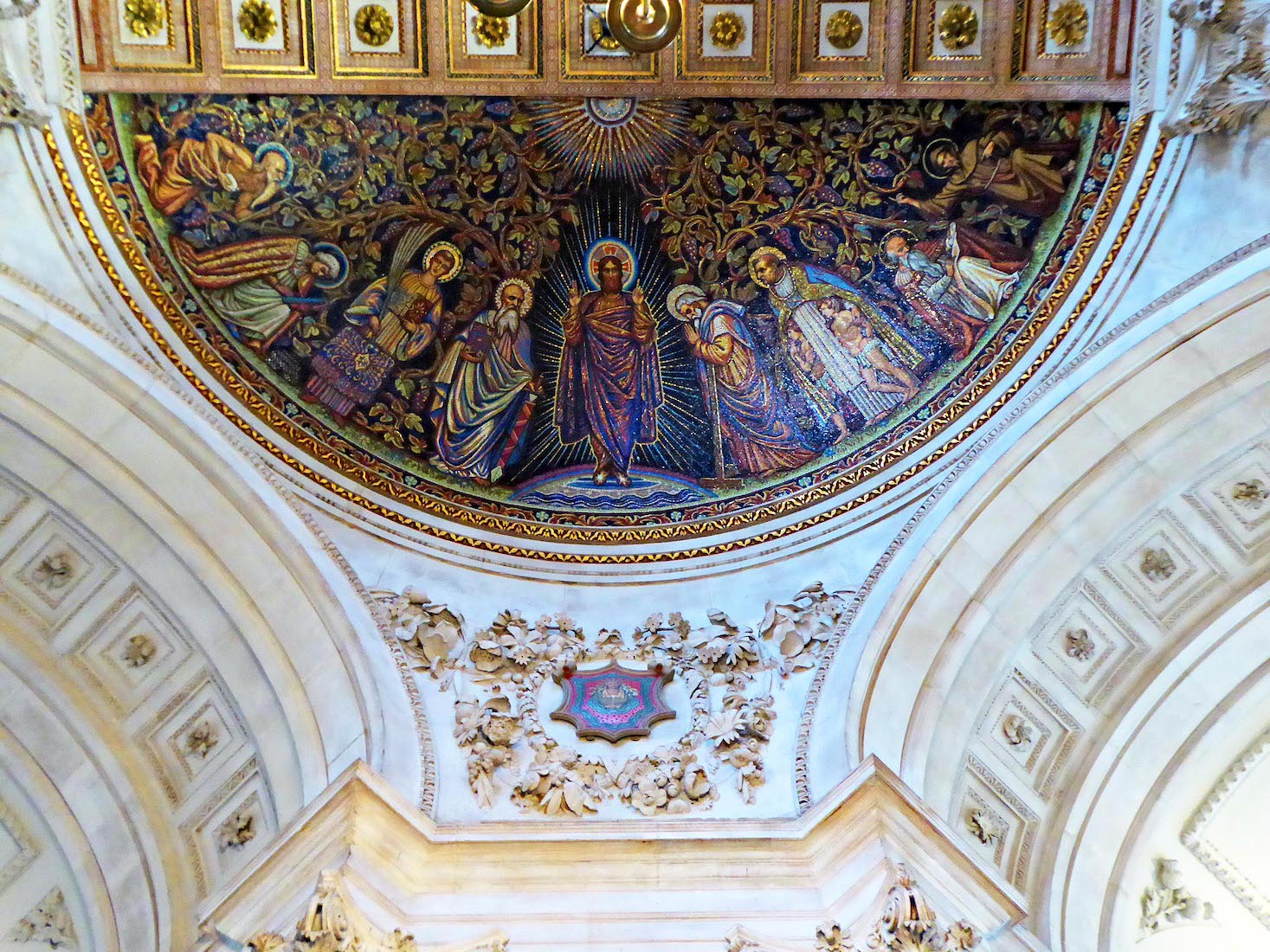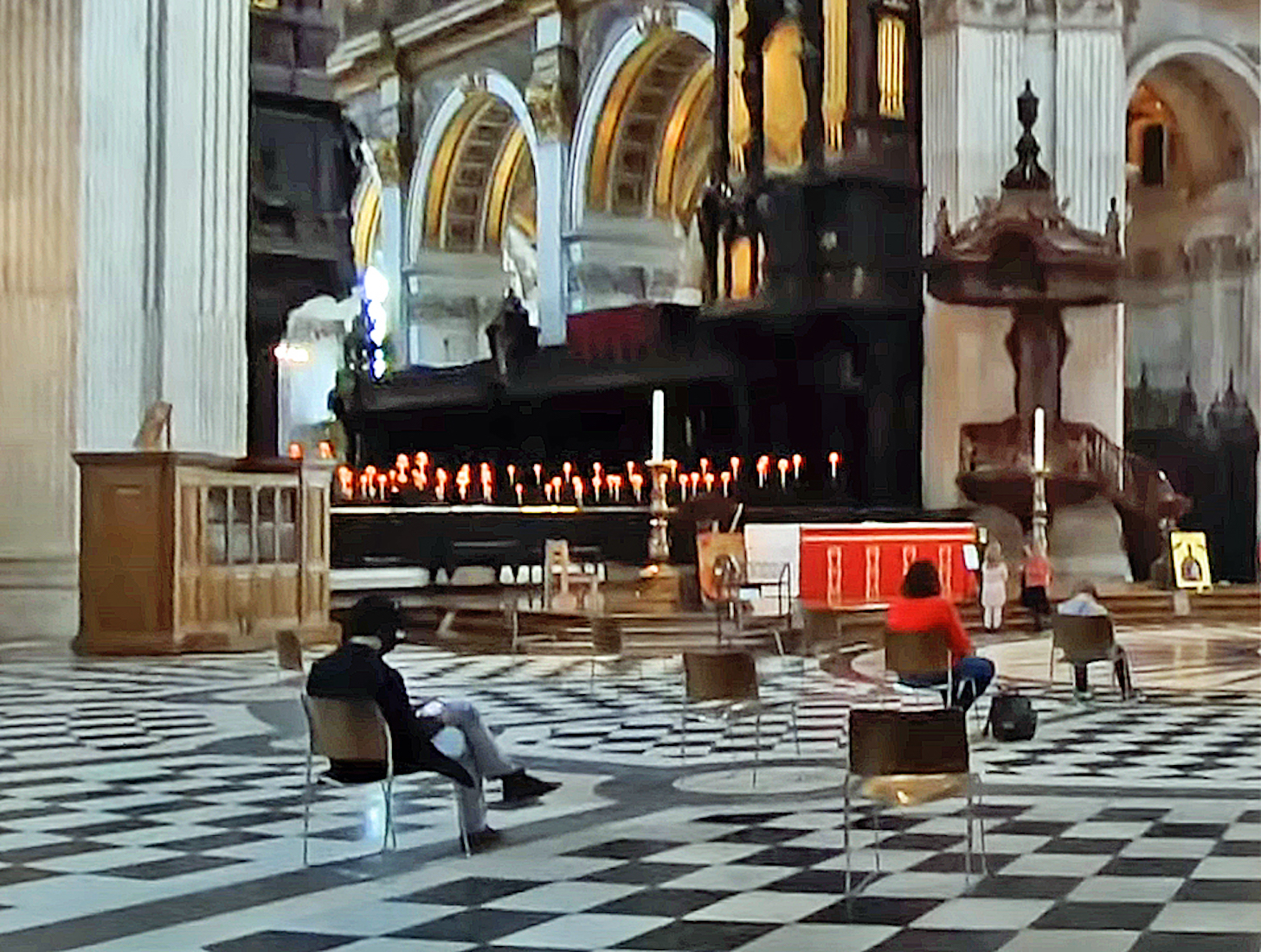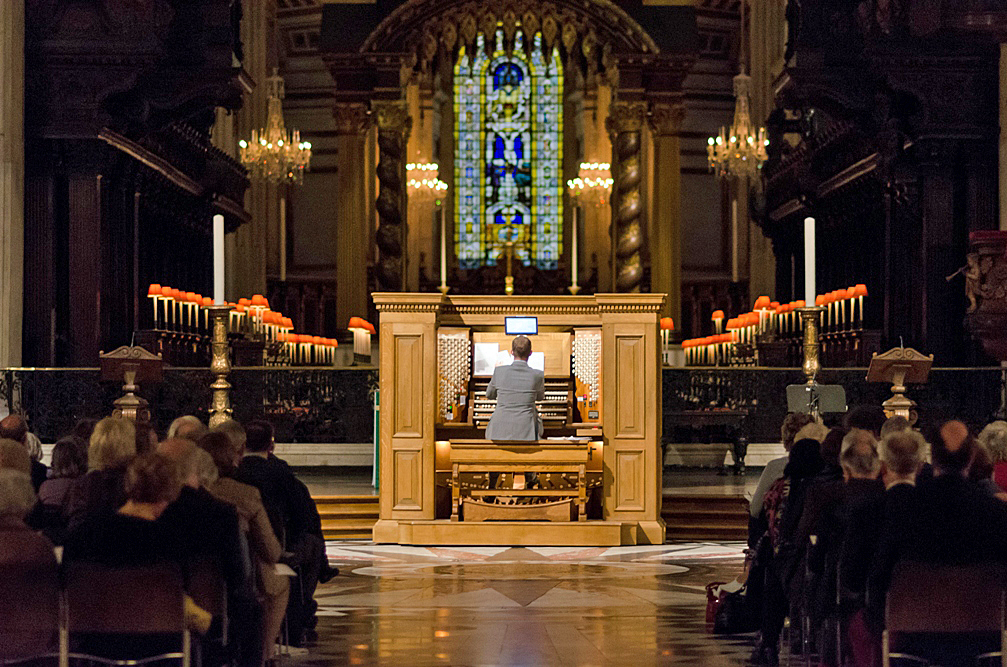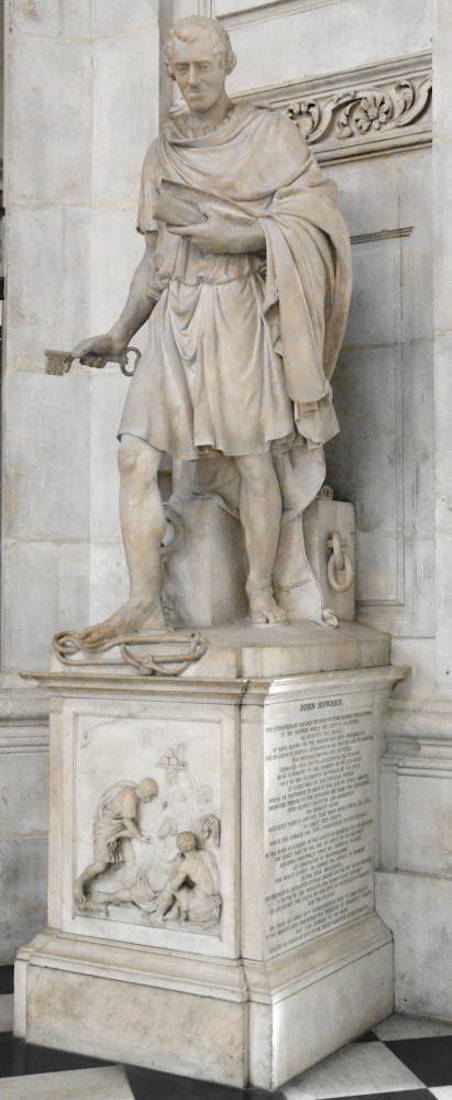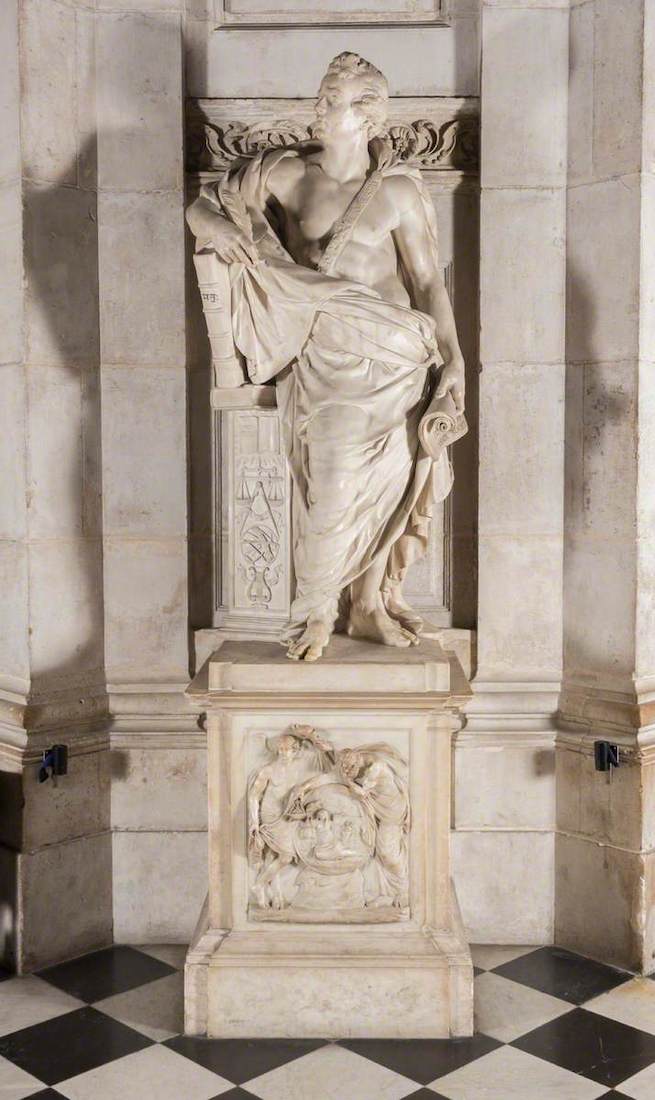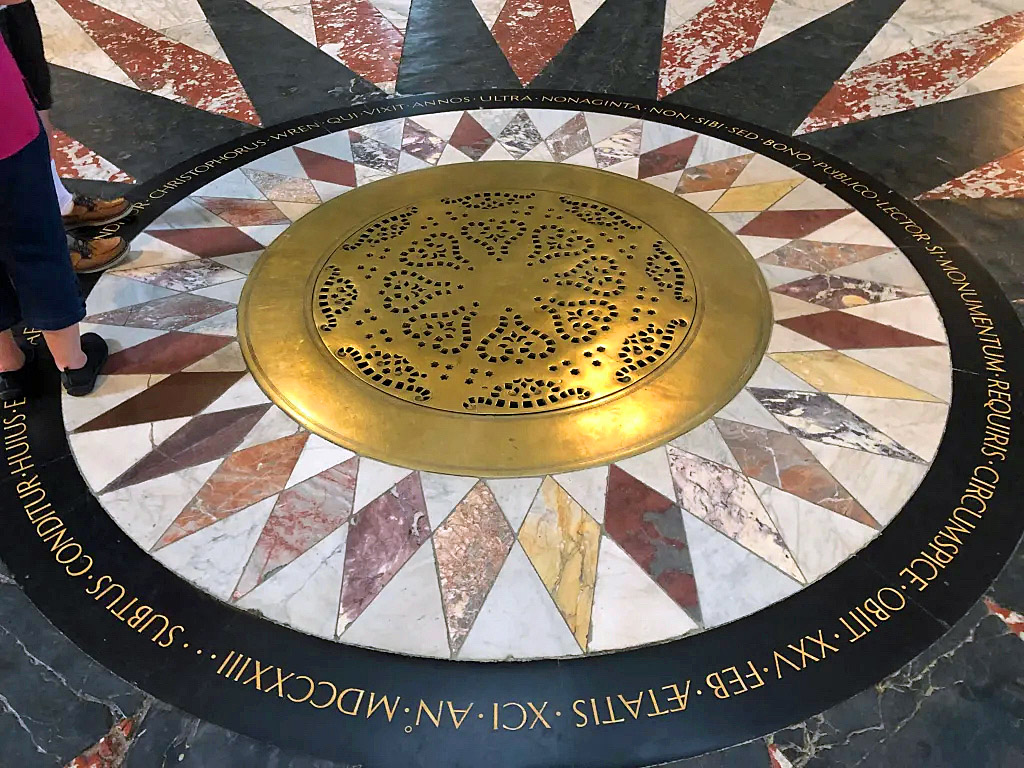THE CROSSING
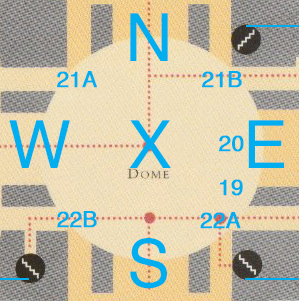
We come next to the crossing – the space beneath the central dome. To the West is the nave. to the East the quire and sanctuary, to the North and South the transepts. There is aso a smaller space in each corner containing a statue. As before, the numbers correspond to the photographs in the following section.
X1. CROSSING LOOKING NORTH AMT
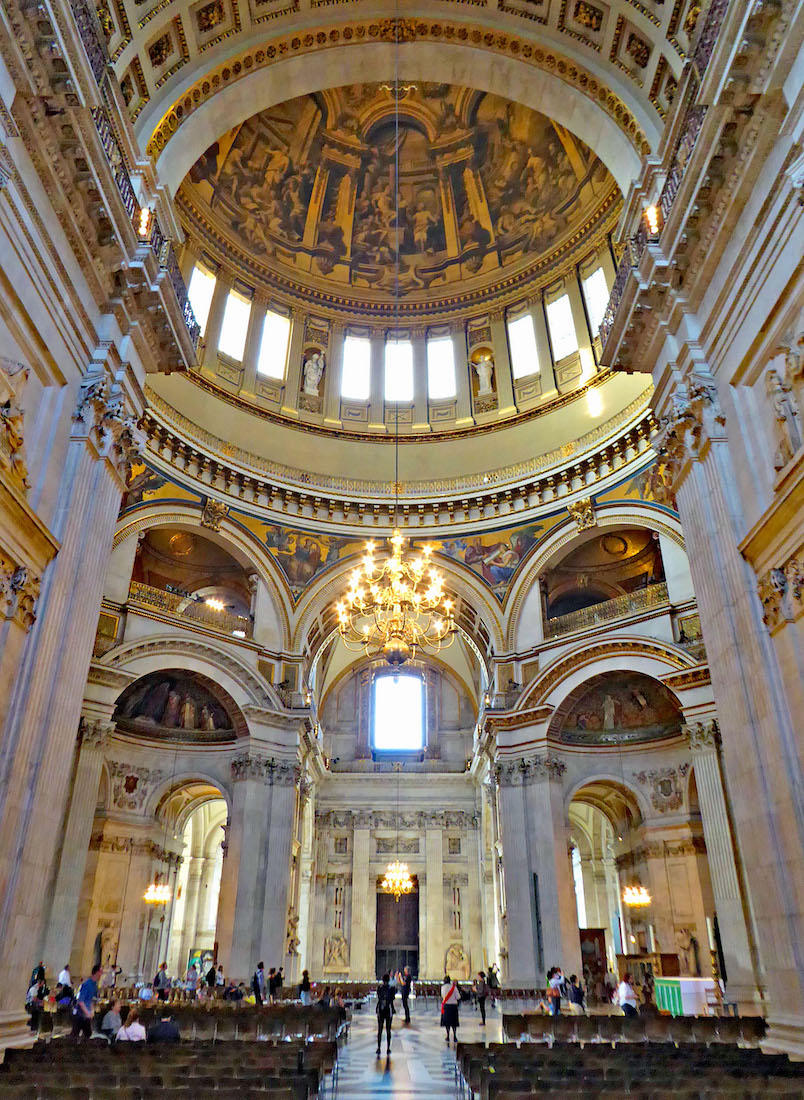
We stand in the crossing and look towards the North transept The vast spaciousness of this Cathedral is felt even more here, with the dome above us – the inner height of the dome is 225 feet (69 metres). There is so much to observe here. To the sides, the ‘spherical’ mosaics cap two of the corner areas of the dome space; for each there is a coat of arms behind, and below we can see one of the four corner statues. A large chandelier hangs from the centre of the dome, and around the dome’s base is a famous walkway – the Whispering Gallery. The nave altar at right gives us some sense of orientation! INDEX
X3. THE CENTRAL CROSSING AMT
This view towards the South transept emphasises the floor of the crossing: a dramatic pointed star. Lying down in the middle to take a photograph of the dome may well be frowned upon by the authorities!
X4. BENEATH THE DOME, LOOKING EAST AMT
We take time to look up into the dome. Above the Whispering Gallery there is a set of eight statues, each statue in its own niche. Below the Gallery are eight curved ‘triangular’ mosaics which we will investigate more closely. So much detail!.
X5. DOME FROM DIRECTLY BELOW AMT
Sir James Thornhill (1675/76 – 1734) was awarded the commission to decorate the dome of St Paul’s, a task he took on after completing the painted hall at Greenwich. It took a little over two years for the main section of the dome to be embellished with an ambitious cycle of eight religious history paintings, each depicting a well-known episode from the life of St. Paul chosen from the Acts of the Apostles. These figurative bays, painted with a muted palette of stone-like browns, are framed by a continuous arcade of painted arches that visually rest upon the supporting columns below. The effect is an interior that is magnificent in scale but subdued in color and pleasing in effect.
X6. DETAIL OF THE DOME AMT
This zoomed in view shows some of the detail of the painting of the dome.
X7. DOME BORDER ST MATTHEW (N of E) AMT
We look now at the eight mosaics which appear beneath the Whispering Gallery. They depict the four Evangelists: Matthew, Mark, Luke and John and the four Major Prophets: Isaiah, Ezekiel, Daniel and Joshua. Shown here is St Matthew, accompanied by a winged man or angel. Matthew's gospel starts with Joseph's genealogy from Abraham; it represents Jesus' Incarnation, and so Christ's human nature. This signifies that Christians should use their reason for salvation.
X8. DOME BORDER ST MARK (E of N) AMT
Following around in a clockwise direction we come to a mosaic depicting St Mark. Mark is shown with a winged lion – a figure of courage and monarchy. The lion also represents Jesus’ resurrection (because lions were believed to sleep with open eyes, a comparison with Christ in the tomb), and Christ as king. This signifies that Christians should be courageous on the path of salvation.
X9. DOME BORDER ST LUKE (E of S) AMT
Next is St Luke, conveniently labelled at the base of the mosaic. He is shown with a winged ox or bull, the traditional symbol for Luke in Christian art, and supposedly representing the emphasis of sacrifice in his Gospel.
X10. DOME BORDER ST JOHN (S of E) AMT
Continuing around in a clockwise direction, the next mosaic depicts the evangelist St John, along with his sign – the eagle. The Gospel of John starts with an eternal overview of Jesus the Logos and goes on to describe many things with a ‘higher’ christology than the other three (synoptic) gospels; it represents Jesus’s Ascension, and Christ’s divine nature. This symbolizes that Christians should look on eternity without flinching as they journey towards their goal of union with God.
X11. DOME BORDER ISAIAH (S of W) AMT
Isaiah. The four major prophets (Isaiah, Jeremiah, Ezekiel and Daniel) of the Old Testament are often displayed (as here) as parallel to the four evangelists, (Matthew, Mark, Luke and John) of the New Testament.
X12. DOME BORDER JEREMIAH (W of S) AMT
The Old Testament prophet Jeremiah is next. These prophets are also represented by symbols: for example Jeremiah by a stone, a switch, or a scroll, but none of these is apparent here.
X13. DOME BORDER EZEKIEL (W of N) AMT
Next, the prophet Ezekiel is pictured inscribing on a stone tablet – perhaps some angelic text?
X14. DOME BORDER DANIEL (N of W) AMT
Finally there is Daniel, clutching at a scroll? But no sign of lions here ... .
X15. LOWER MOSAIC (NE) AMT
The four square corners of the space below the dome are partly capped by ‘spherical’ (quarter-dome) mosaic scenes, showing the death and resurrection of Christ. This scene shows Jesus on the cross, but coming from behind is the tree of life. The mosaics were done by William Blake Richmond, and are particularly beautiful.
X16. LOWER MOSAIC (SW) AMT
This scene is entitled ‘The Entombment’. It depicts, in a rather fanciful way, the body of Jesus being placed in the tomb.
X17. LOWER MOSAIC (SE) AMT
This third scene shows Jesus coming out from the cave tomb. On either side there is an angel, and the prostrate bodies of the Roman guards lying on the ground.
X18. LOWER MOSAIC (NW) AMT
The final scene is of the Ascension: Christ physically departing from Earth by rising into Heaven in the presence of his disciples.
X19. PULPIT AMT
The nave pulpit is made of stained timber, and accessed by a wonderfull crafted curved staircase. There is a large octagonal canopy above, with a crucifix on the support. The carved decorative detail on the front of the pulpit includes crossed swords, and a couple of horn-blowing cherubs. The pulpit was designed by Christopher Wren, and the carvings are the work of Grinling Gibbons.
X20. NAVE ALTAR SPC
The main feature of the crossing (apart from the dome!) is the nave altar, standing on a raised platform, and flanked by two very large candlesticks. [Photo Credit: St Paul’s Cathedral] Before we leave this crossing area, we investigate the statues in the four corner spaces, beneath the ‘quarter domes’.
X21. THE MOBILE ORGAN CONSOLE SPC
The Grand Organ of St Paul’s has a mobile console which is (usually) located in the crossing. This console is identical to the main console: each has 137 drawstops and 140 controls. The operating system needed to make this set-up work utilises the same technology as the NASA space shuttle programme and the International Space Station! [Photo Credit: St Paul’s Cathedral]
X22. JOSHUA REYNOLDS (NW) AND SAMUEL JOHNSON (NE) SPC SPC
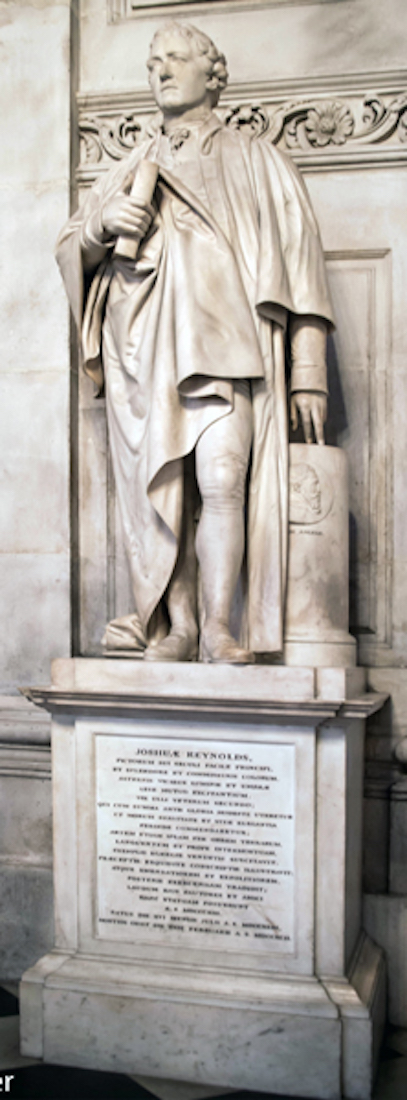
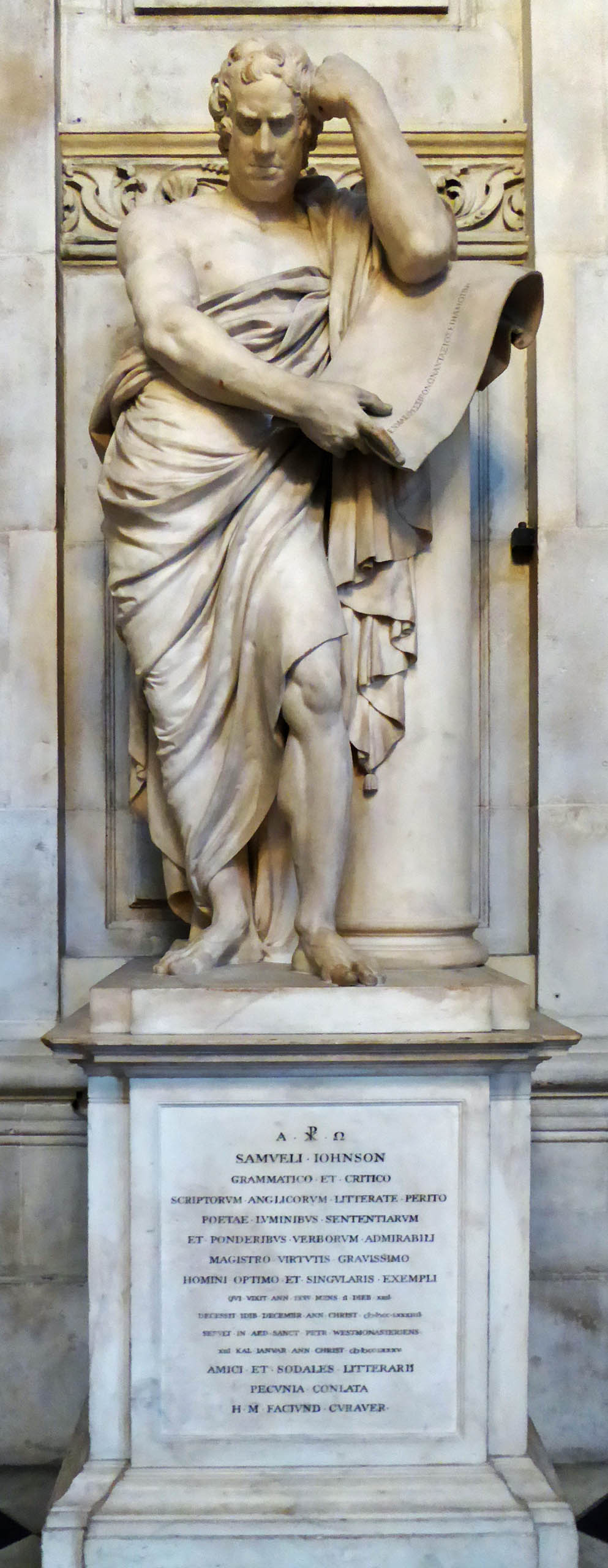
In this grouping (X21, X22) there are four marble statues of great 18th century contributors to various aspects of human endeavour. At left, above, is Sir Joshua Reynolds PRA FRS FRSA (1723 – 1792). He was an English painter, specialising in portraits. John Russell said he was one of the major European painters of the 18th century. He promoted the ‘Grand Style’ in painting which depended on idealizations of the imperfect. He was a founder and first president of the Royal Academy of Arts, and was knighted by George III in 1769. • At right is Samuel Johnson. Samuel Johnson (1709 – 1784), often called Dr Johnson. He was an English writer who made lasting contributions as a poet, playwright, essayist, moralist, critic, biographer, editor and lexicographer. [Photo Credits: St Paul’s Cathedral]
X23. JOHN HOWARD (SE) AND WILLIAM JONES (SW) SPC
Shown at left is John Howard FRS (1726 –1790) who was a philanthropist and early English prison reformer. • Sir William Jones FRS FRAS FRSE (1746 – 1794) was an Anglo-Welsh philologist, a puisne judge on the Supreme Court of Judicature at Fort William in Bengal, and a scholar of ancient India, particularly known for his proposition of the existence of a relationship among European and Indo-Aryan languages, which he coined as Indo-European. Jones is also credited for establishing the Asiatic Society of Bengal in the year 1784. We now leave the crossing and move to the North transept. [Photo Credits: St Paul’s Cathedral]
X24. CENTRAL DISK AMT
Directly underneath the dome is a marble disk with a central brass dedicated to Sir Christopher Wren in Latin: Here in its foundations lies the architect of this church and city, Christopher Wren, who lived beyond ninety years, not for his own profit but for the public good. Reader, if you seek his monument, look around you. Died 25 Feb. 1723, age 91. [Photo Credit: Nick Pangere]


